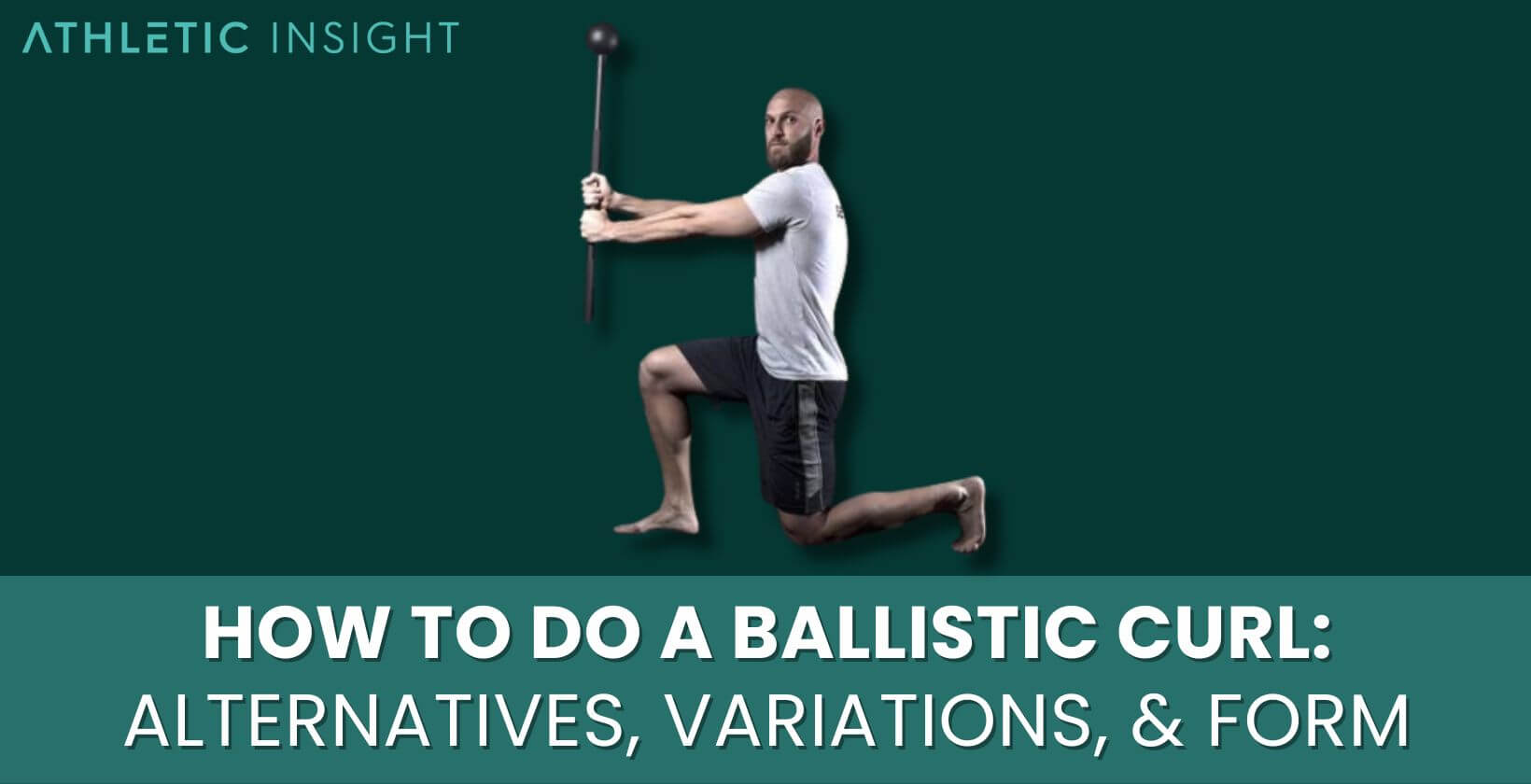Looking to elevate your fitness routine with something a bit more dynamic? Enter the ballistic curl, a high-velocity variant of the traditional bicep curl that’s designed to supercharge your muscle growth and endurance. This exercise isn’t just about lifting; it’s about propelling your fitness to new heights with explosive movements.
In this article, you’ll discover the ins and outs of the ballistic curl, from its foundational mechanics to its profound benefits. Whether you’re a seasoned athlete or just starting your fitness journey, mastering the ballistic curl could be your next game-changer. For most, the ballistic curl is achieved with a steel mace.
What is a Ballistic Curl?
A ballistic curl stands out as an advanced twist to your classic bicep curl. By integrating high-velocity movements into the exercise, it accelerates your muscle engagement. Unlike the steady tempo of traditional curls, ballistic curls involve a swift upward motion followed by a controlled descent. This not only targets the biceps but also improves neuromuscular efficiency, making your muscles more responsive.

The technique leverages momentum, transitioning into the area of plyometric training, which is often reserved for enhancing explosive power and speed. Ideal for fitness enthusiasts seeking to elevate their workout intensity, ballistic curls offer a path to superior muscle endurance and agility. Incorporating this dynamic variant into your regimen promises a fresh challenge and potential gains beyond what static exercises can deliver.
What Muscles Do Ballistic Curls Work?
When you perform ballistic curls, you’re engaging a plethora of muscles, much more than in a traditional curl. Primarily, your biceps brachii are the stars of the show, flexing dynamically with each rapid movement. But it doesn’t stop there.
Your brachialis and brachioradialis muscles, nestled beneath the biceps, also enter the fray, working hard to stabilize and support the swift motions. These muscles help in the flexing of your forearm, essential in the curling action.
Also, your forearm muscles get a piece of the action too, tightening and relaxing as you grip and release the weight. Do not overlook the deltoids, which although not the main focus, play a critical role in managing the ballistic movement, so receiving a subtle but effective workout.
By engaging these groups, ballistic curls offer a comprehensive arm workout, touching on strength, endurance, and agility, all without the need for a many of exercises.
How to do a Ballistic Curl?
To perform a dumbbell curl effectively, begin standing with feet apart, holding dumbbells with palms forward. Curl the weights to your shoulders quickly, using momentum but controlling the movement, keeping elbows still. Engage your core to stay stable. Lower the weights carefully to start, readying for the next repetition.
1. Starting Position
Stand upright, feet shoulder-width apart. Hold a dumbbell in each hand, palms facing forward. Arms should hang by your sides. Keep your chest out and shoulders back. This is your starting point.
2. Executing the Movement
Quickly and with force, curl the weights towards your shoulders. Imagine throwing the dumbbells upward but keep a tight grip. Your elbows should not move; they stay by your sides.
3. Using Momentum Wisely
The movement relies on momentum. As you thrust the weights upward, it’s not just about speed but control. Engage your core to stabilize your body and prevent swinging.
5. Returning to Start Position
After the curl, let the dumbbells fall back to the starting position but control the descent. Don’t let gravity do all the work. Prepare for the next rep as soon as the weights are back in position.
What are the Common Mistakes of the Ballistic Curl?
When diving into the ballistic curl, you’re bound to encounter common pitfalls that can hinder your progress. Using too much weight is a frequent mistake. It’s tempting to go heavy, but this often sacrifices form and can lead to injury. Start with lighter weights and gradually increase as you gain confidence and strength.
Another hiccup is neglecting the core. The core stabilizes your body, enabling a more efficient and safer lift. Ignoring this crucial component can decrease the effectiveness of your workout and put undue strain on your spine.
Rushing through reps also diminishes the exercise’s efficacy. Although momentum is key, it’s vital to maintain control throughout the movement to ensure you’re fully engaging the targeted muscles.
Finally, inconsistent elbow positioning can compromise form. Keep your elbows fixed to your sides to prevent them from flaring out, ensuring a concentrated workload on the biceps.
What are the Benefits of Ballistic Curls?
When you jump into ballistic curls, you’re not just working out your biceps. This dynamic exercise enhances muscular power, boosting your ability to perform quick, forceful movements. It’s like turbocharging your muscles, gearing them up for better performance in sports and daily tasks. The neuromuscular adaptation is significant, meaning your brain and muscles communicate faster, making you more agile.
Improved coordination is another gem. By integrating your body’s movements, ballistic curls refine your motor skills, making complex actions smoother. These curls are also excellent for breaking monotony in your workout regime, introducing an explosive element that can rekindle your motivation.
Remember, while the allure of ballistic curls is strong, the mastery lies in the execution. Missteps can hinder progress, so focus on form and progression.
What are the Risks of Ballistic Curls?
Ballistic curls, while beneficial, carry certain risks if not performed correctly. The primary concern is the potential for muscle strain or injury. These exercises involve rapid, explosive movements that can stress your muscles and joints beyond their comfort zone. Without proper form, you might experience micro-tears in your muscle fibers, leading to pain and discomfort.
Another risk pertains to joint health. The ballistic nature of these curls puts excessive pressure on your elbows and shoulders. Over time, this can lead to joint wear and tear or exacerbate existing conditions like tendinitis.
Finally, incorrect execution can nullify the intended benefits. Instead of enhancing your muscular strength and agility, improper ballistic curls could impede your progress by encouraging bad form that’s hard to correct.
Remember, mastering the technique is the key to minimizing these risks.
What are the Variations of a Ballistic Curl?
The variations of a ballistic curl are the standing ballistic curl with dumbbells, seated ballistic curl, ballistic hammer curl, alternate arm ballistic curl, and banded ballistic curl. These variations allow for you to work the same muscles but with different approaches.
1. Standing Ballistic Curl with Dumbbells
You’ll start this variation by standing up straight, holding a dumbbell in each hand. Propel the weights upwards with a swift, explosive motion. It’s key to keep your elbows close to your body to prevent strain.
2. Seated Ballistic Curl
Performing ballistic curls while seated adds stability, allowing you to focus on the arm movement. Sit on a bench, dumbbells in hand, and launch them upwards, ensuring your back remains straight throughout the exercise.
3. Ballistic Hammer Curl
This variation changes the game by adjusting your grip. Hold the dumbbells with your thumbs facing up, akin to a hammer. Explode upward, keeping your wrists locked to engage the brachialis muscle effectively.
4. Alternate Arm Ballistic Curl
Add a twist by alternating arms. Lift one dumbbell with the ballistic curl technique, switch to the other arm, and keep alternating. This method boosts coordination and evens out muscle development.
5. Banded Ballistic Curl
Incorporate resistance bands for an innovative approach. Secure the band under your feet and hold the ends with both hands. Execute the ballistic curl with the added resistance, enhancing muscle engagement and adding a fresh challenge to your workout.
What are the Alternatives to a Ballistic Curl?
The alternatives to the ballistic curl are traditional bicep curls, hammer curls, concentration curls, preacher curls and cable curls.
1. Traditional Dumbbell Bicep Curls
Traditional bicep curls are foundational. You use dumbbells or a barbell to lift in a smooth, controlled motion. The dumbbell bicep curl exercise zeroes in on your biceps, offering a solid base for arm strength.
2. Hammer Curls
Hammer curls tweak the grip. Instead of palms up, your palms face inward. This minor change targets not just your biceps but also your brachialis. It’s a comprehensive tactic for robust arm development.
3. Concentration Curls
Concentration curls demand focus. For concentration curls, you sit with one arm resting against your leg, and curl a weight toward you. This isolation move profoundly engages the biceps, ensuring meticulous muscle growth.
4. Preacher Curls
Preacher curls use a bench for support. Arms positioned over the bench prevent momentum cheat, emphasizing bicep contraction. The preacher curl is an effective strategy for refining muscle shape.
5. Cable Bicep Curls
Cable bicep curls use a cable machine for resistance, offering constant tension throughout the motion. The cable bicep curl is an advanced method, promoting maximum bicep engagement and endurance.
Key Takeaways
- Ballistic curls are an advanced, high-velocity version of traditional bicep curls, designed to enhance muscle growth, endurance, and neuromuscular efficiency through explosive movements.
- This exercise engages not only the biceps but also the brachialis, brachioradialis, forearm muscles, and deltoids for a comprehensive arm workout that improves strength, endurance, and agility.
- Proper execution of ballistic curls involves a rapid, controlled upward motion of the weights while keeping the elbows fixed, using momentum wisely, and stabilizing the body with the core to prevent injuries.
- Common mistakes in performing ballistic curls include using too much weight, neglecting core stability, rushing through repetitions, and inconsistent elbow positioning, which can lead to decreased effectiveness and increased risk of injury.
- The benefits of ballistic curls extend beyond muscle strengthening to include enhancing muscular power, coordination, and breaking workout monotony, though there are risks such as muscle strain and joint pressure if not performed correctly.
- Variations of the ballistic curl, including standing, seated, hammer, alternate arm, and banded ballistic curls, offer ways to diversify the exercise and adapt it to different fitness levels and goals.



